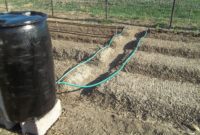A gravity fed irrigation system is a cheap effective way to provide water for a smaller sized crop area. It would be especially cost effective if the climate of the area can provide enough precipitation to consistently keep a reservoir filled using rain water harvesting techniques. The basic system is very simple consisting of an elevated reservoir with a pipe coming out the bottom that feeds water into a basic drip irrigation system that is all controlled either by hand or with a very efficient battery powered timer that controls the rate at which the crop is watered.

The components needed include:
1. A water reservoir
- It must be able to contain at least one days worth of water
- The greater the capacity of the reservoir is proportional to how often it must be refilled
- The complication of having a very large container is that you must elevate it above the crop and refilling a very high container is more work
- The reason to elevate the tank is that it adds pressure which needs to be kept consistent at the point where the drip lines are fed so that the water is distributed equally
- A structure to support the water reservoir
- Can be constructed of anything that can support the weight of the container when it is filled with water
- It must also be able to withstand outside forces such as the wind
- An 880 gal container full weighs 4 tons
- Piping
- There must be a pipe at the base of the reservoir that lets water flow out and having a shut off valve at this connection point is a good idea if the reservoir is larger than one days worth of water.
- The piping if using the timer method then feeds the water through a filter
- Different sized piping should be used to increase the pressure
- This is done by gradually decreasing the size of the lines being used such as starting with a 2ft line at the base of the reservoir then decreasing the size every 1-4ft so that it would then be a 1ft, 6in, 3in, 1in, 1/2in, down to the 1/8in emitters in the drip lines
- Timer and Filter
- There are many models of battery powered timers that can be set up and run for a whole season
- These timers control the frequency that water is emitted into the drip lines
- A filter must be installed in the water line before the timer valves
- This prevents the smaller lines from becoming clogged
- Valves and Drip lines
- Shut off valves should be placed between the reservoir pipes and the irrigation pipes and before the timer valves
- Drip lines are the average lines and emitters that can be purchased at any garden supply store
